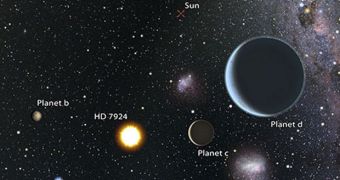A study published earlier this week in the Astrophysical Journal and authored by University of Hawaii astronomers and fellow researchers announces the discovery of a previously undocumented planetary system not far from our cosmic neighborhood.
This new planetary system was identified and located with the help of ground-based telescopes in Hawaii, California and Arizona. Thus, the telescopes allowed the researchers to zoom in on a star known as HD 7924 and detect slight changes in the light originating from it.
As explained in the Astrophysical Journal report, the shifts in the light produced by HD 7924 could only be caused by planets orbiting the star and hiding part of its surface from view on their journey. All in all, the team of astronomers counted three planets.
“The team discovered the new planets by detecting the wobble of the star HD 7924 as the planets orbited and pulled on the star gravitationally,” the researchers explained in a statement.
It is unlikely that the system is habitable
The newly discovered planetary system is located merely 54 light-years away. Astronomers say that the planets that comprise it have orbits of just 5, 15 and 24 days, respectively.
The data produced by the ground-based telescopes used in this investigation indicates that the planets sit fairly close to their parent star. Thus, the distance between them and HD 7924 is smaller than the one between Mercury and our Sun, i.e. about 58 million kilometers (36 million miles).
This means that the planets, each much bigger than Earth, are probably too hot and receive too much radiation to be able to support the emergence and evolution of life, researchers explain.
“The three planets are unlike anything in our solar system, with masses 7-8 times the mass of Earth and orbits that take them very close to their host star,” astronomer Lauren Weiss said in an interview.
Astronomers plan to go on studying nearby stars. The goal is to produce a census of all the planets orbiting stars found within a 100 light-year radius of our Sun.

 14 DAY TRIAL //
14 DAY TRIAL //